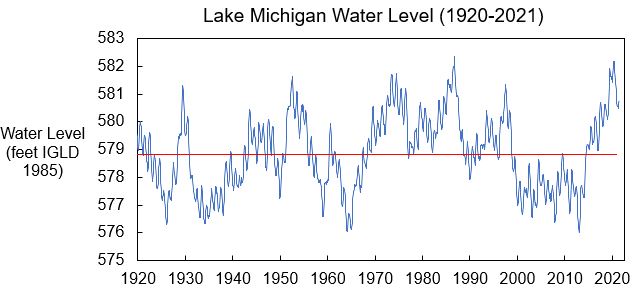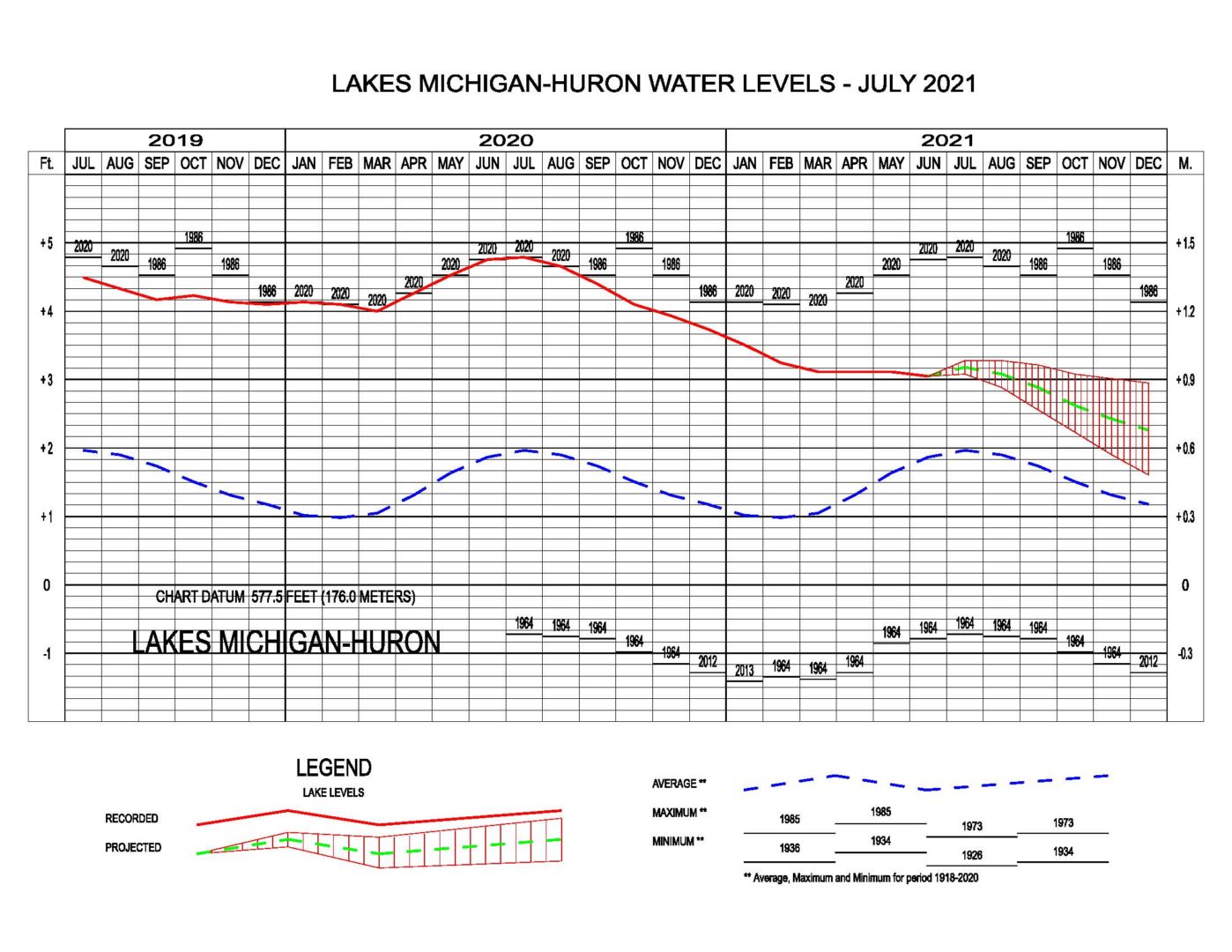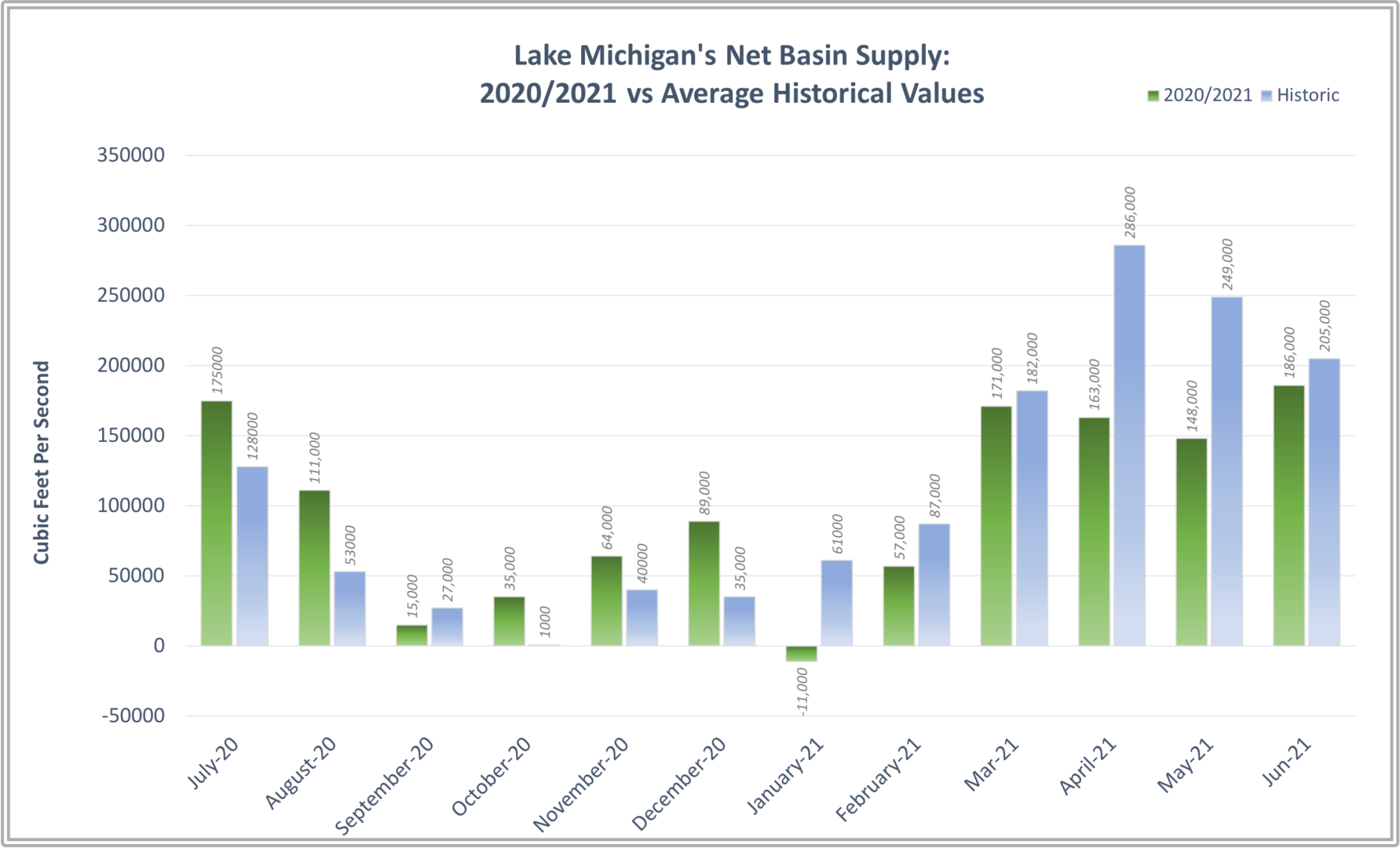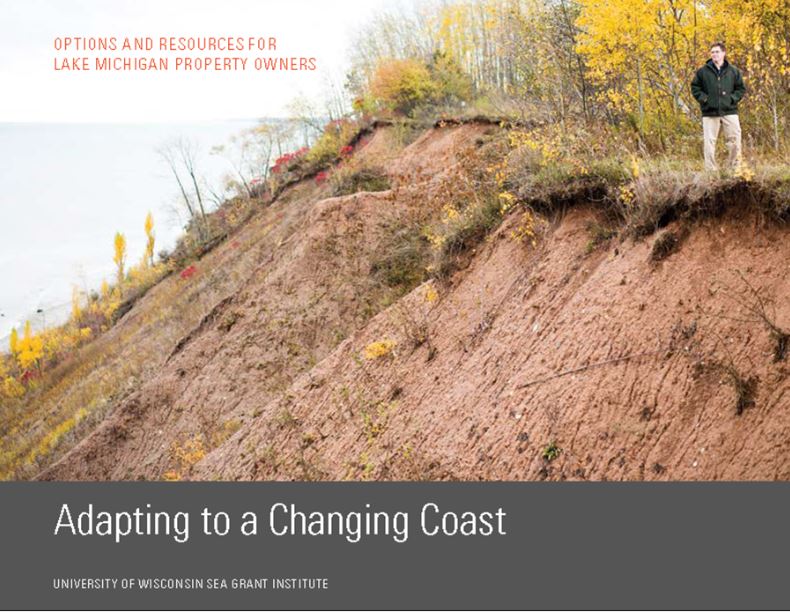
The water levels on all the Great Lakes have continued to be below their monthly record highs as of July 9, 2021. Lake Michigan is now 19 inches below the highest recorded monthly average in July previously set just last year in 2020. Water levels are trending downwards and this can be explained by the Net Basin Supply (NBS). This past June is the fifth month in a row this year where NBS has been below average. While summer tends to be the season where lake levels increase, Lake Michigan is expected to decrease around 1-2 inches by this same time next month.
Water Levels on Lake Michigan-Huron
Quick links to other July website updates:
Around the Great Lakes: Cleveland Metroparks recreates Lake Erie Shoreline
Resource of the Month: Blue Accounting for the Great Lakes
Here are five things to know about water levels on Lake Michigan for July 2021.
What are the current water levels on Lake Michigan?
The water level of Lake Michigan as of July 9, 2021, is at an elevation of 580.68 feet above sea level (from the International Great Lakes Datum). To put this level into perspective, here are some statistics for Lake Michigan relative to the period of water level records measured from 1918 to present: (statistics from USACE’s Weekly Water Level Update and USACE’s Water Level Summary
| Compared to… | Current Water Levels are… |
| One month ago | 2 inches higher |
| One year ago | 18 inches lower |
| Long-term July monthly average (1918 to 2020) | 15 inches higher |
| Record July monthly mean (set in 2020) | 19 inches lower |
What is the outlook for future water levels?
Water levels on Lake Michigan increased by 2 inches since last month. The USACE is projecting that water levels will decrease by about 1 or 2 inches by August 2021 (see six-month forecast issued for June 2021 below). An increase in water levels generally occurs throughout the spring as precipitation and snowmelt typically increase. They tend to level off then decrease at the end of the summer and through the fall as temperatures cool, evaporation increases, and wind speeds pick up. In an average year, water levels vary seasonally by about one foot from a peak in summer to a low in winter, though every year is different. You can read more about this as well as other myths on water level fluctuations on this blog.

Six-month water level forecast for Lake Michigan issued for this month. Source: U.S. Army Corps of Engineers. https://www.lre.usace.army.mil/Missions/Great-Lakes-Information/Great-Lakes-Water-Levels/Water-Level-Forecast/Monthly-Bulletin-of-Great-Lakes-Water-Levels/
What is behind Great Lakes water level fluctuations?
The story of Great Lakes water level changes is told by Net Basin Supply. Net Basin Supply (NBS) accounts for water going into a lake in the form of precipitation and runoff minus water leaving a lake due to evaporation of water from the lake surface. In general, when Net Basin Supply is positive, more water enters the lake than leaves, causing a rise in lake levels. Over the last five years, Net Basin Supply has been consistently positive, driving all the Great Lakes to rise. Click here for more detail.
In June 2021, Lake Michigan water levels have increased despite a below-average Net Basin Supply. This tells us that the Net basin supply cannot only be relied upon to predict increasing or decreasing water levels. A rise in water levels last month could have been caused by a few factors. First, is higher amounts of precipitation, around 29% above its average for the month. Second, there was a higher outflow from the Lake Michigan-Huron basin to Lake Erie through the St. Claire River than average. And third, other atmospheric conditions such as evaporation have an effect. The combination of these three factors could have led to an increase in water levels.
Lake Michigan’s NBS for the year 2020 was cumulatively above average. 2021 has flipped its trend, now, with NBS inputs below the historic average. For 2020, in total, there was more water entering the Lake than leaving compared to a normal year, which drove Lake Michigan to consistently have monthly record highs. The NBS so far for 2021, is seeing less water entering the lake and more water leaving. You can see on the chart below, when the green bar (2020/2021 NBS) is higher than the blue bar (historic average NBS), more water enters the lake than on average for that month (and vice versa). In order for Lake Michigan water levels to actually go down appreciably (beyond just seasonal fluctuations), we would need to consistently see green bars lower than the blue bars.

This image shows a comparison between the current and the average NBS recorded between 1900 – 2008. Calculations based on the Army Corps of Engineers Great Lakes Basin Hydrology Summaries. https://www.lre.usace.army.mil/Missions/Great-Lakes-Information/Great-Lakes-Information-2/Basin-Conditions/
What is making water levels go down?
The historic record shows that water levels in the Great Lakes fluctuate between periods of highs and low with changes in precipitation and evaporation, so we know our high water levels will not be around forever. In fact, we have already started to see lake levels decreasing. But what are the perfect conditions that would help water levels go down sooner rather than later? The answer given by Keith Kompoltowicz, Deputy Chief of Engineering at the USACE’s Detroit District, last year was “If the faucet turns off, and we return to very dry, a hot dry summer. Those would be the conditions that would pull water levels down“. In other words, low precipitation and runoff with high evaporation would lead to a below-average Net Basin Supply. This is exactly what we are starting to see now. The Great Lakes Integrated Sciences and Assessments (GLISA) report, Assessing the Impacts of Climate Variability and Change on Great Lakes Evaporation explains that the combination of water temperature, air temperature, wind, winter ice cover, and precipitation affect the rate of evaporation. “Evaporation rates from the Great Lakes can get as high as 0.4-0.6 inches per day” but measuring the effect is way more complicated you might expect. If you are curious to learn more about what drives lake level fluctuation check out the blog, Myth Busting Evaporation on the Great Lakes and other Water Level Fluctuations.
Places you can find more relevant  information
information
- Our Coastal Hazards page for details about the impacts of high water levels, including erosion, flooding, and navigation issues.
- Our blog post Resources for Great Lakes Coastal Property Owners: Where do I start? has links to many resources to help
- understand coastal hazards
- weigh the risks coastal hazards pose to property
- understand options for addressing these hazards
- get started on implementing actions if necessary.
- The Great Lakes Water Budgets from the University of Michigan gives more information about what makes the lakes go up and down.
- The US Army Corps’ Great Lakes Information page has tons of details on view water level data, water level forecasts, basin conditions, outflows, etc.
- Our Resource of the Month on US Army Corps of Engineers Monthly Bulletin of Great Lakes Water Levels.




